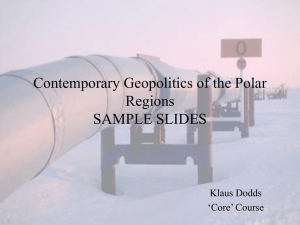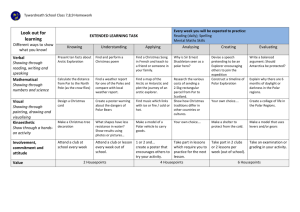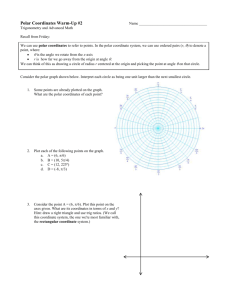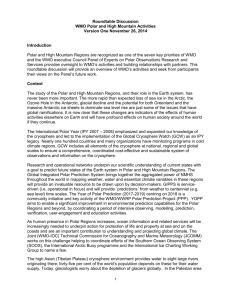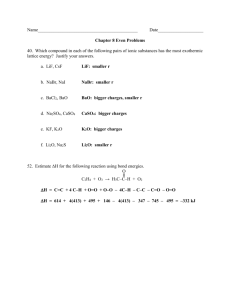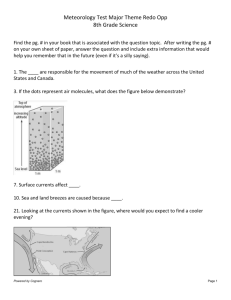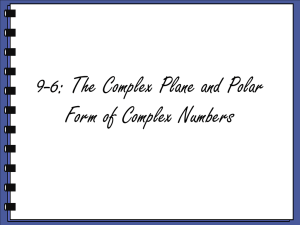here - WMO
advertisement
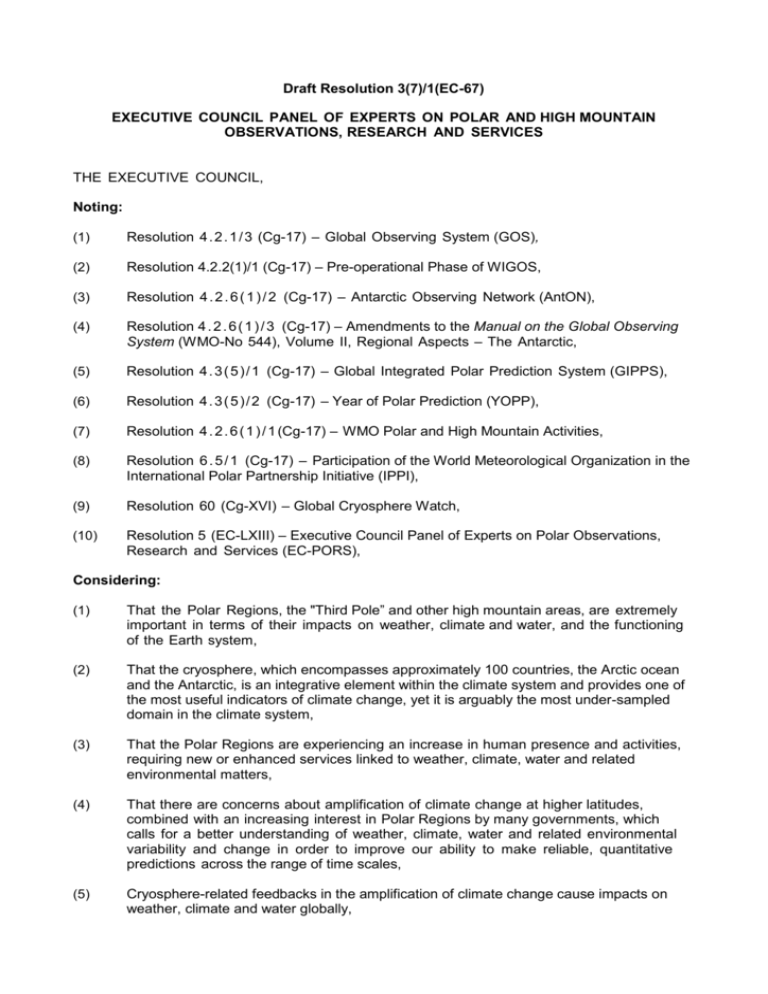
Draft Resolution 3(7)/1(EC-67) EXECUTIVE COUNCIL PANEL OF EXPERTS ON POLAR AND HIGH MOUNTAIN OBSERVATIONS, RESEARCH AND SERVICES THE EXECUTIVE COUNCIL, Noting: (1) Resolution 4 . 2 . 1 / 3 (Cg-17) – Global Observing System (GOS), (2) Resolution 4.2.2(1)/1 (Cg-17) – Pre-operational Phase of WIGOS, (3) Resolution 4 . 2 . 6 ( 1 ) / 2 (Cg-17) – Antarctic Observing Network (AntON), (4) Resolution 4 . 2 . 6 ( 1 ) / 3 (Cg-17) – Amendments to the Manual on the Global Observing System (WMO-No 544), Volume II, Regional Aspects – The Antarctic, (5) Resolution 4 . 3 ( 5 ) / 1 (Cg-17) – Global Integrated Polar Prediction System (GIPPS), (6) Resolution 4 . 3 ( 5 ) / 2 (Cg-17) – Year of Polar Prediction (YOPP), (7) Resolution 4 . 2 . 6 ( 1 ) / 1 (Cg-17) – WMO Polar and High Mountain Activities, (8) Resolution 6 . 5 / 1 (Cg-17) – Participation of the World Meteorological Organization in the International Polar Partnership Initiative (IPPI), (9) Resolution 60 (Cg-XVI) – Global Cryosphere Watch, (10) Resolution 5 (EC-LXIII) – Executive Council Panel of Experts on Polar Observations, Research and Services (EC-PORS), Considering: (1) That the Polar Regions, the "Third Pole” and other high mountain areas, are extremely important in terms of their impacts on weather, climate and water, and the functioning of the Earth system, (2) That the cryosphere, which encompasses approximately 100 countries, the Arctic ocean and the Antarctic, is an integrative element within the climate system and provides one of the most useful indicators of climate change, yet it is arguably the most under-sampled domain in the climate system, (3) That the Polar Regions are experiencing an increase in human presence and activities, requiring new or enhanced services linked to weather, climate, water and related environmental matters, (4) That there are concerns about amplification of climate change at higher latitudes, combined with an increasing interest in Polar Regions by many governments, which calls for a better understanding of weather, climate, water and related environmental variability and change in order to improve our ability to make reliable, quantitative predictions across the range of time scales, (5) Cryosphere-related feedbacks in the amplification of climate change cause impacts on weather, climate and water globally, p. 2 (6) That there remain key gaps in scientific understanding of processes and interactions in Polar Regions, including boundary layer behaviour, polar clouds and precipitation, sea ice/ocean dynamics, hydrology, permafrost and ice sheet dynamics, and the functioning of the Earth system, (7) That there is a continuing need for weather, climate, hydrological and related environmental data from the Polar Regions, including enhancement and development of instruments and methods of observation suited to these areas; for the full implementation of the World Weather Watch and the Global Framework for Climate Services (GFCS); and for the full realization of the value of research, monitoring and prediction of hydrology, climate change, atmospheric composition and the ozone layer over the Polar Regions, observational networks in polar regions be closely coordinated with the implementation of WIGOS, and designed to improve in a most efficient way the capability of Members to provide the widening range of operational services and to better serve research programme requirements, (8) That there is an ongoing need to formalize the WMO responsibilities for the Antarctic as a region not covered by any of the WMO Regional Associations, and that the establishment and maintenance of an Antarctic Observing Network (AntON) of surface and upper-air stations to meet the requirements of Members are among the most important obligations of Members under Article 2 of the WMO Convention, (9) That the density of the current Antarctic Observing Network of surface and upper-air stations is much less than what is needed to properly characterize Antarctic weather and climate, (10) That cryospheric operational and research observing networks, including AntON, should be integrated within the framework of WIGOS and the WMO Information System (WIS) and be enhanced to include cryosphere-related variables according to the GCW Implementation Plan, (11) That the Seventeenth Congress decided to continue the decadal endeavour towards a Global Integrated Polar Prediction System (GIPPS), as an International Polar Year (IPY) Legacy to benefit the global community, (12) That the Seventeenth Congress noted the Concept for the International Polar Partnership Initiative (IPPI) and agreed to participate in IPPI, (13) That the Seventeenth Congress decided to implement the Global Cryosphere Watch (GCW) during the next financial period as one of the major efforts of the Organization with the goal that GCW should become operational, (14) That the High Mountain Activities will be a part of the development and implementation of the Global Cryosphere Watch (GCW), Decides: (1) To establish the Executive Council Panel of Experts on Polar and High Mountain Observations, Research and Services; (2) That the Panel will be composed of members nominated by the Permanent Representatives of Members, including Parties to the Antarctic Treaty, and participants p. 3 from other relevant organizations that have active meteorological, hydrological, oceanographic or cryospheric programmes, in particular in the Polar Regions; (3) That observers from other groups may be invited to attend meetings of the Panel; (4) That the Panel shall make recommendations to the Executive Council within its terms of reference, including the recommended Antarctic Observing Network and applicable standard practices, especially recommendations for updates of the relevant parts of the Manual on the Global Observing System (WMO-No. 544), the Manual on the Global Telecommunication System (WMO-No. 386), and the Manual on the Global Data-processing and Forecasting System (WMO-No. 485), as well as other relevant Manuals and Guides, such as those for WIS, WIGOS and services to users in the Polar Regions; (5) That the Panel will undertake the following: For Polar Regions: (a) To develop and promote an integrated approach to understanding the global impact of changes in Polar Regions so that the required services may be provided to users and governments may be advised on aspects of adaptation; (b) To ensure that operational and research observing networks in polar regions (including AntON) are integrated within the framework of WIGOS and WIS and are enhanced to include cryosphere-related variables; (c) To engage in a concerted effort to involve WMO Members, Technical Commissions and Regional Associations, as well as relevant research and international organizations and bodies, in improving predictive capability in Polar Regions on timescales from hours to centuries; (d) To establish a high-level WMO partnership in activities aimed at securing the IPY observing system legacy in close cooperation with operational agencies in Member countries and international organizations that have a great interest in Polar Regions, such as the Sustaining Arctic Observing Networks (SAON); (e) To oversee and guide the development and implementation of GCW in collaboration with technical commissions, regional associations and relevant WMO and international programmes, organizations, institutions and bodies; (f) To oversee and guide the Polar Space Task Group (PSTG) that provides coordination across space agencies to facilitate acquisition and distribution of fundamental satellite datasets, and to contribute to or support development of specific derived products in support of cryospheric scientific research and applications; (g) To guide the development of GIPPS in collaboration with technical commissions, regional associations and relevant international programmes, organizations and bodies; (h) To coordinate WMO participation in the International Polar Partnership Initiative; (i) To facilitate the acquisition, exchange and archiving of observational data from Polar Regions in compliance with WIGOS requirements related to instruments, p. 4 data exchange (WIS) and the Quality Management Framework (QMF), and to underpin the provision of services required for the polar regions; (j) To provide a forum for discussion of relevant scientific issues and make recommendations on meteorological, hydrological, oceanographic and cryospheric research and operations related to the Polar Regions; (k) To provide regular input on issues related to polar meteorology, hydrology, oceanography and the cryosphere to support the activities of relevant groups or bodies, such as the World Climate Programme (WCP) that includes Global Climate Observing System (GCOS), World Climate Research Programme (WCRP) and the World Climate Services Programme (WCSP); the Global Atmosphere Watch programme (GAW) and the World Weather Research Programme (WWRP); the Global Framework for Climate Services (GFCS), and WMO Technical Commissions, Regional Associations and Programmes; (l) To ensure close collaboration with and contribute to the other international organizations, committees and programmes concerned, such as the Antarctic Treaty Consultative Meeting (ATCM), the Arctic Council, the Scientific Committee on Antarctic Research (SCAR), the International Arctic Science Committee (IASC), the International Association of Cryospheric Sciences (IACS) and other relevant associations of the International Union of Geodesy and Geophysics (IUGG), the Council of Managers of National Antarctic Programmes (COMNAP), the Forum of Arctic Research Operators (FARO), and the Intergovernmental Oceanographic Commission (IOC) of the United Nations Educational, Scientific and Cultural Organization (UNESCO), and the International Hydrological Programme (IHP) of UNESCO; For the Antarctic: The Panel should cooperate, as appropriate, with other relevant international and regional entities: (a) To promote the execution of the resolutions of Congress and the Executive Council in the area from 60ºS to 90ºS; (b) To coordinate programmes of surface and upper-air meteorological observations in the Antarctic, working with relevant international scientific organizations, and liaise with regional associations in relation to sub-Antarctic observations; (c) To coordinate design of the Antarctic Observing Network, comprising surface and upper-air stations, including the GCOS Surface Network (GSN), GCOS Upper-Air Network (GUAN), Global Atmosphere Watch (GAW) and other relevant observing components; (d) To coordinate standardization of observing, coding, data exchange and data management practices applied for the Antarctic; (e) To propose recommendations to the Antarctic Treaty System (ATS); For the Arctic: p. 5 (a) While appropriate functions are covered by respective regional associations, the Panel may liaise with them in defining appropriate components of Arctic observing systems and services; (b) To guide, in collaboration with the Commission for Hydrology, the development of the Arctic Hydrological Cycle Observing System (Arctic-HYCOS) Project; For the High Mountain Regions: Contribute to the work of the regional associations, technical commissions and programmes in defining appropriate components of high mountain regions’ hydrometeorological and cryospheric observing systems and services; Authorizes the Panel to establish sub-groups and task teams as and when required, including in particular an Antarctic Task Team (ATT), PSTG, a GCW Steering Group, and the GCW Teams, including a High Mountain Task Team; Requests the Secretary-General: (1) To maintain the membership of the Panel in accordance with the relevant Regulations in consultation with the co-chairpersons and Members concerned; (2) To formally invite the Arctic Council Arctic Monitoring and Assessment Programme (AMAP), International Arctic Science Committee (IASC) and Scientific Committee on Antarctic Research (SCAR) to participate in the Panel as members; (3) To provide the necessary support to activities and sessions of the Panel, including the GCW working structure, and liaise with relevant international organizations, programmes and bodies. _________ _______ Note: This resolution replaces Resolution 5 (EC-LXIII), which is no longer in force.
